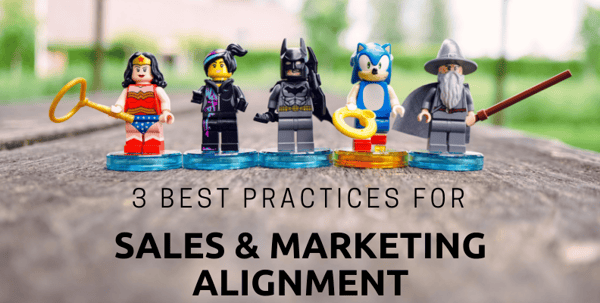
In 2006 Harvard Business Review published an article titled "Ending the War Between Sales and Marketing"; today in 2018, more than an entire decade later, I am here to confirm that the war is indeed not over, and perhaps is even more muddled since the battleground has transcended into digitally ruled terrain. In fact, according to Forrester Research, only 8% of companies have strong alignment between their sales and marketing departments. I think we can all agree that 8% doesn't qualify as a big "W" and certainly isn't anything to write home about.
I don't solely intend to regurgitate how stagnant the sales and marketing ecosystem is. Rather, I would like to share the methodology that we here at Revenue River use to help bridge the gap between the two silos. This sales enablement strategy revolves around maintaining 3 best practices: plan, build and manage. If that sounds too oversimplified, I can assure you that I will get into the nitty-gritty details that these 3 tiers encompass. Keep in mind that this is an ever-evolving and on-going process that will not be achieved in a 3-punch knockout. However, by categorizing every effort you invest toward strengthening sales and marketing alignment under a planning, building or managing stage, you will be able to take a step back, see the forest through the trees, and make real progress toward a unified sales and marketing dynamic.
WHY AREN'T SALES AND MARKETING ALIGNED?
Before we jump into how to use the plan, build, manage (PBM) strategy, let's take a moment to review why sales and marketing alignment is such a cluster and why it needs to be straightened out. I'll start out by listing three of the main pain points:
 1. Communication - big shocker, eh? I can honestly say that in every marketing interview I've ever had, some variation of the question "can you deal with strong personalities?" has come up. To be fair, the two departments typically attract different types of people with different goals. Marketers tend to be methodical, creative and focused on achieving strategic outcomes which often equate to long-term goals. In contrast, sales professionals are assertive and intentional, making shit happen on the front lines of customer engagement to hit their immediate goals. In this competitive environment, disparities in personalities and priorities tends to result in detrimental misunderstandings. Unfortunately, these misunderstandings usually evolve into opportune scapegoats for missing the mark.
1. Communication - big shocker, eh? I can honestly say that in every marketing interview I've ever had, some variation of the question "can you deal with strong personalities?" has come up. To be fair, the two departments typically attract different types of people with different goals. Marketers tend to be methodical, creative and focused on achieving strategic outcomes which often equate to long-term goals. In contrast, sales professionals are assertive and intentional, making shit happen on the front lines of customer engagement to hit their immediate goals. In this competitive environment, disparities in personalities and priorities tends to result in detrimental misunderstandings. Unfortunately, these misunderstandings usually evolve into opportune scapegoats for missing the mark.
2. Mismatched Revenue Strategy - With different leadership comes differing goals and KPIs. A revenue strategy promotes direct alignment between marketing and sales by building a prioritized development roadmap outlined by key milestones that are relevant to both sales and marketing. After all, when sales and marketing teams work together, companies see 36% higher customer retention and 38% higher sales win rates (MarketingProfs). The final destination of this roadmap should lead you to the Promised Land of increased and measurable marketing ROI, sales productivity and growth.
3. The Customer - As SalesForce eloquently puts it, "the modern buyer is digitally driven, socially connected, mobile, and empowered, with nearly unlimited access to information and people." To further drive the point home, according to the 2016 Demand Gen Report, 47% of B2B buyers view 3-5 pieces of sales content before speaking to a sales person. This means that the top third of the sales cycle is irrelevant and the traditional sales process is inapplicable. Buyers are tech savvy and prefer to do their own research before ever engaging with salespeople; therefore, it is absolutely essential that sales and marketing work in tandem.
WHY SHOULD SALES AND MARKETING ALIGN?
Why it's necessary to pull the reigns back on this wild stag is pretty self explanatory:
- Revenue generation should be more efficient and effective.
- Marketing campaigns should be focused on the best producing topics and channels.
- Marketing should provide sales with buyer data.
- Sales should receive a high volume of hot leads from marketing.
- Sales should be utilizing quality content that marketing creates.
- Sales should relay constructive feedback from the field back to marketing.
So, things are a bit messy, but here's where the PBM strategy comes into play. To untangle this complicated knot I'll demonstrate how to organize your next steps with a few examples.
Protip: To get the most out of this strategy, I'd highly recommend you begin to calendar and label your tasks under its respective label. I personally label and color code every event on my calendar under one of these 3 tiers. If you're doing it right, you should have a beautiful blend of planning, building and managing tasks throughout your work week.
PLAN
Keep in mind, this sales enablement strategy isn't linear; you should always be circling back to the planning stage. Two common examples of what should take place in this stage include:
 1. Collaboration - this hits on communication, our #1 pain point. The cadence in which sales and marketing meets is entirely up to you. What seems to work best for many is holding monthly departmental meetings along with weekly or bi-weekly leadership meetings baked in. In these meetings you should be gathering as much feedback as possible to better understand the existing opportunities and challenges that sales and marketing encounter. Preliminary meetings may entail discussions intended to develop clear definitions of what a sales qualified lead is, and when it should be handed off from marketing to sales. If 61% of all B2B marketers send all leads to sales even though only 27% of those leads will be qualified, I can understand why some tension may begin to fester between sales and marketing.
1. Collaboration - this hits on communication, our #1 pain point. The cadence in which sales and marketing meets is entirely up to you. What seems to work best for many is holding monthly departmental meetings along with weekly or bi-weekly leadership meetings baked in. In these meetings you should be gathering as much feedback as possible to better understand the existing opportunities and challenges that sales and marketing encounter. Preliminary meetings may entail discussions intended to develop clear definitions of what a sales qualified lead is, and when it should be handed off from marketing to sales. If 61% of all B2B marketers send all leads to sales even though only 27% of those leads will be qualified, I can understand why some tension may begin to fester between sales and marketing.
More frequent conversations may revolve around the campaigns targeted throughout the buyer's journey. For example, if sales reps are uncomfortable with the messaging, voice or layout of the material they are presenting, it’s highly likely they will either adapt it to fit their style and selling situation or not use it at all. In fact, a staggering 60-70% of B2B content created is never used. Now is the time encourage the two teams to speak up.
2. Investigation - Current systems or procedures should routinely be challenged or optimized. With so much technology entering the market at any given moment, it can be difficult to remain informed. But the organizations that do their due diligence will have a serious advantage over their competition. This pertains outside of internal processes as well; think about your customer's habits, pain points, and needs when it comes to engaging with you, your product or service. It can be difficult to admit that your best practices are no longer the best, but by challenging these you may be pointed to new paradigms for your business that offer growth opportunities.
BUILD
Once you determine what may result in a healthier sales-marketing ecosystem, it's time to build out your ideas into something more tangible. I'd suggest you begin by ironing out the following:
1. Co-created Revenue Strategy - The aforementioned Revenue Strategy is your foundation, so it's essential that both sales and marketing work together to solidify this early on to avoid any onset cracks. To further strengthen this strategy, it may behoove the two teams to create a Service Level Agreement, or SLA. This entails collaborating on specific goals like how many leads will marketing produce every month, every quarter, or every year. Reversely, the sales organization has to commit to marketing and ensure that they will follow up on leads with a certain frequency and within a specific time-frame.
2. Buyer Personas - Since the top third of the sales funnel is gone it's high-time to understand who your buyers are by deciphering target personas and mapping each target prospect’s buyer journey. By addressing your buyer's challenges you will provide them with solution-focused content. According to Aberdeen, aligning content to specific stages of the buyer’s journey yields 73% higher average conversion rates. Though content strategy is typically determined by marketing, it’s important that sales remain involved to ensure that they approve the messaging and are aware of active campaigns. If your sales team is part of the 65% of sales reps who say they can’t find content to send to prospects, what's the point?
MANAGE
Analysis - Sales can very easily display their part in ROI from closed sales. For marketing, it's a little more difficult and is contingent on the quality of customer data in your CRM as well as sales usage of the CRM. If the information is accurate, your targeting, nurturing, personalization, segmentation and ongoing communication is going to be highly effective at moving your prospects and customers along in their buyer journey. But, if sales isn't properly using the system, performance related data will neither be transmitted or attributed back to marketing. If that's the case, then you simply need to plan a sales and marketing cadence to discuss the disparities, build a sales enablement strategy such as ongoing CRM training to relieve the issue, and manage the hell out of it by pulling weekly audit reports to ensure procedure is being followed. See what I did there? Plan, build, manage.
Feedback - To measure effectiveness outside of hard data, always allow for feedback from sales, marketing and customers. If a salesperson learns that a specific piece of marketing material is what helped sell a customer, make it known. After all, companies with unified sales and marketing teams generate 208% more revenue from marketing. Reversely, if sales is continuously refraining from entering information into the CRM because the process is too time consuming, speak up and see if the process can be standardized through some form of automation. Once again, I will reiterate that communication is key.

Final Thoughts
By no means do I believe the PBM strategy will eradicate misalignment between sales and marketing and end the war. But I do believe that by using this methodology, you will at least win a few battles by fostering a perpetual cycle of progression. Plan out effective strategies, build them, manage them, rinse and repeat. By doing so, you will increase ROI, productivity and efficiency, and encourage positive interdepartmental work culture.
RevRiv Reader Recap


